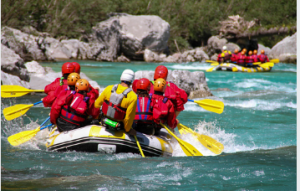A whitewater raft is one of the essential accessories you will own during a trip. It provides safety, but it is also an excellent way to have fun with friends. However, there are some things to keep in mind when buying one. These tips can help you find the best whitewater raft for you. Read on to learn about some of the best options. SL13: This raft is made of rigid
It is one of the most versatile and durable SL13 whitewater rafts. With its high centre of gravity, it tumbles on rougher water but is still suitable for experienced paddlers. It is not as suitable for technical whitewater, but it works well on rivers with large recovery pools and easy entry/exit points. The price is also comparatively low. This model can fit into the trunk of a mid-sized car or SUV, making it easy to transport.
Despite being the most popular SL13 raft, it has a few shortcomings that make it a poor choice for some water runs. First of all, it’s too heavy. When you’re trying to paddle a river in low water, you won’t be able to handle the weight. The weight causes the raft to pin itself. The tubes are made from tough PVC. The SL13 has an approximately eight cubic feet internal volume, making it ideal for small lakes.
SL13 is a featherweight raft
 The SL13 is a lightweight inflatable whitewater raft with plenty of features and is ideal for a multi-day river trip. This raft has room for three adults and is suited for two to four paddlers. The self-bailing floor drains automatically and has a drop-stitch construction, providing stability and strength in whitewater waves. The raft also features 10 D-rings on the bow and stern for attaching a paddle.
The SL13 is a lightweight inflatable whitewater raft with plenty of features and is ideal for a multi-day river trip. This raft has room for three adults and is suited for two to four paddlers. The self-bailing floor drains automatically and has a drop-stitch construction, providing stability and strength in whitewater waves. The raft also features 10 D-rings on the bow and stern for attaching a paddle.
The construction of the Outdoor-Play whitewater rafts is also essential. Many rafts are made of one of three materials: urethane, PVC, and Hypalon. While urethane is the lightest material, it is also expensive and hard to store. For these reasons, Aire uses urethane in their air bladders. Other manufacturers, however, use other materials to make their rafts lighter and more durable.
The Super Duper Puma raft is a popular model. It is fourteen feet long and can carry up to seven riders. It is perfect for Class four and five rapids. Its narrow width and high tear resistance make it great for those snaking through narrow stretches. It also has an air chamber, which keeps you dry. It is designed for fast, easy paddling and is also lightweight.
SL13 is tougher than PVC
If you’re looking for a high-end whitewater raft, the material you choose will depend on your preferences. There are many choices in the market, such as urethane, Hypalon, or polyvinyl chloride. All have pros and cons, but the SL13 is tougher than PVC. The difference is most evident in the price, but that doesn’t mean that you can’t find a budget-friendly model.
Aside from durability, SL13 is also more lightweight than PVC. This material is less expensive than PVC and has a longer lifespan. However, getting an American-made model is better if you’re looking for a more stable boat. PVC rafts with double layers of fabric are more difficult to roll and store. Rocky Mountain, GeneOne, and Aqualine are among the brands that can roll and store easily.
Hypalon: Although Hypalon is the newer material, PVC is still the more common option for a whitewater raft. It offers better abrasion resistance and moderate friction. In addition, Hypalon rafts can resist higher temperatures than PVC. Hypalon rafts are more durable than PVC and can be used for years. You’ll probably need patches and repair work once in a while, but the warranty isn’t that long.
Urethane rafts have several advantages over their PVC counterparts. It has elastomeric memory properties, which means that it will return to its original shape when stretched. In addition, urethane is a non-brittle material, so it resists cracking even under shock load. In addition, urethane is more durable than PVC.
